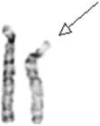An interstitial 15q11-q14 deletion: expanded Prader-Willi syndrome phenotype
- PMID: 20082457
- PMCID: PMC2814996
- DOI: 10.1002/ajmg.a.33197
An interstitial 15q11-q14 deletion: expanded Prader-Willi syndrome phenotype
Erratum in
- Am J Med Genet A. 2010 May;152A(5):1331-2
Abstract
We present an infant girl with a de novo interstitial deletion of the chromosome 15q11-q14 region, larger than the typical deletion seen in Prader-Willi syndrome (PWS). She presented with features seen in PWS including hypotonia, a poor suck, feeding problems, and mild micrognathia. She also presented with features not typically seen in PWS such as preauricular ear tags, a high-arched palate, edematous feet, coarctation of the aorta, a PDA, and a bicuspid aortic valve. G-banded chromosome analysis showed a large de novo deletion of the proximal long arm of chromosome 15 confirmed using FISH probes (D15511 and GABRB3). Methylation testing was abnormal and consistent with the diagnosis of PWS. Because of the large appearing deletion by karyotype analysis, an array comparative genomic hybridization (aCGH) was performed. A 12.3 Mb deletion was found which involved the 15q11-q14 region containing approximately 60 protein coding genes. This rare deletion was approximately twice the size of the typical deletion seen in PWS and involved the proximal breakpoint BP1 and the distal breakpoint was located in the 15q14 band between previously recognized breakpoints BP5 and BP6. The deletion extended slightly distal to the AVEN gene including the neighboring CHRM5 gene. There is no evidence that the genes in the 15q14 band are imprinted; therefore, their potential contribution in this patient's expanded PWS phenotype must be a consequence of dosage sensitivity of the genes or due to altered expression of intact neighboring genes from a position effect.
Copyright 2010 Wiley-Liss, Inc.
Figures



Similar articles
-
Expanded Prader-Willi syndrome due to chromosome 15q11.2-14 deletion: report and a review of literature.Am J Med Genet A. 2013 Jun;161A(6):1309-18. doi: 10.1002/ajmg.a.35909. Epub 2013 Apr 30. Am J Med Genet A. 2013. PMID: 23633107 Review.
-
Prenatal diagnosis of a 15q11.2-q14 deletion of paternal origin associated with increased nuchal translucency, mosaicism for de novo multiple unbalanced translocations involving 15q11-q14, 5qter, 15qter, 17pter and 3qter and Prader-Willi syndrome.Taiwan J Obstet Gynecol. 2021 Mar;60(2):335-340. doi: 10.1016/j.tjog.2021.01.012. Taiwan J Obstet Gynecol. 2021. PMID: 33678338
-
De novo interstitial duplication of the 15q11.2-q14 PWS/AS region of maternal origin: Clinical description, array CGH analysis, and review of the literature.Am J Med Genet A. 2010 Aug;152A(8):1925-32. doi: 10.1002/ajmg.a.33447. Am J Med Genet A. 2010. PMID: 20575009
-
Genomic analysis of the chromosome 15q11-q13 Prader-Willi syndrome region and characterization of transcripts for GOLGA8E and WHCD1L1 from the proximal breakpoint region.BMC Genomics. 2008 Jan 28;9:50. doi: 10.1186/1471-2164-9-50. BMC Genomics. 2008. PMID: 18226259 Free PMC article.
-
Expanded Prader-Willi Syndrome due to an Unbalanced de novo Translocation t(14;15): Report and Review of the Literature.Cytogenet Genome Res. 2019;159(3):109-118. doi: 10.1159/000504159. Epub 2019 Dec 10. Cytogenet Genome Res. 2019. PMID: 31816617 Review.
Cited by
-
Prader-Willi syndrome genetic subtypes and clinical neuropsychiatric diagnoses in residential care adults.Clin Genet. 2018 Mar;93(3):622-631. doi: 10.1111/cge.13142. Epub 2018 Feb 5. Clin Genet. 2018. PMID: 28984907 Free PMC article.
-
Prader-Willi syndrome and early-onset morbid obesity NIH rare disease consortium: A review of natural history study.Am J Med Genet A. 2018 Feb;176(2):368-375. doi: 10.1002/ajmg.a.38582. Epub 2017 Dec 22. Am J Med Genet A. 2018. PMID: 29271568 Free PMC article. Review.
-
Single Gene and Syndromic Causes of Obesity: Illustrative Examples.Prog Mol Biol Transl Sci. 2016;140:1-45. doi: 10.1016/bs.pmbts.2015.12.003. Epub 2016 Mar 23. Prog Mol Biol Transl Sci. 2016. PMID: 27288824 Free PMC article. Review.
-
Early Detection and Management of Prader-Willi Syndrome in Egyptian Patients.J Pediatr Genet. 2019 Dec;8(4):179-186. doi: 10.1055/s-0039-1695042. Epub 2019 Aug 4. J Pediatr Genet. 2019. PMID: 31687254 Free PMC article.
-
Protooncogenic Role of ARHGAP11A and ARHGAP11B in Invasive Ductal Carcinoma: Two Promising Breast Cancer Biomarkers.Biomed Res Int. 2023 Nov 23;2023:8236853. doi: 10.1155/2023/8236853. eCollection 2023. Biomed Res Int. 2023. PMID: 38046902 Free PMC article.
References
-
- Autio SH, Pihko H, Tengstrom C. Clinical features in a de novo interstitial deletion 15q13 to q15. Clin Genet. 1988;34:293–298. - PubMed
-
- Brunetti-Pierri N, Sahoo T, Frioux S, Chinault C, Zascavage R, Cheung SW, Peters S, Shinawi M. 15q13q14 deletions: phenotypic characterization and molecular delineation by comparative genomic hybridization. Am J Med Genet A. 2008;146A:1933–1941. - PubMed
-
- Butler MG, Lee PKD, Whitman BY. Management of Prader-Willi Syndrome. 3rd. New York, NY: Springer; 2006.
Publication types
MeSH terms
Grants and funding
LinkOut - more resources
Full Text Sources
Medical
Miscellaneous

